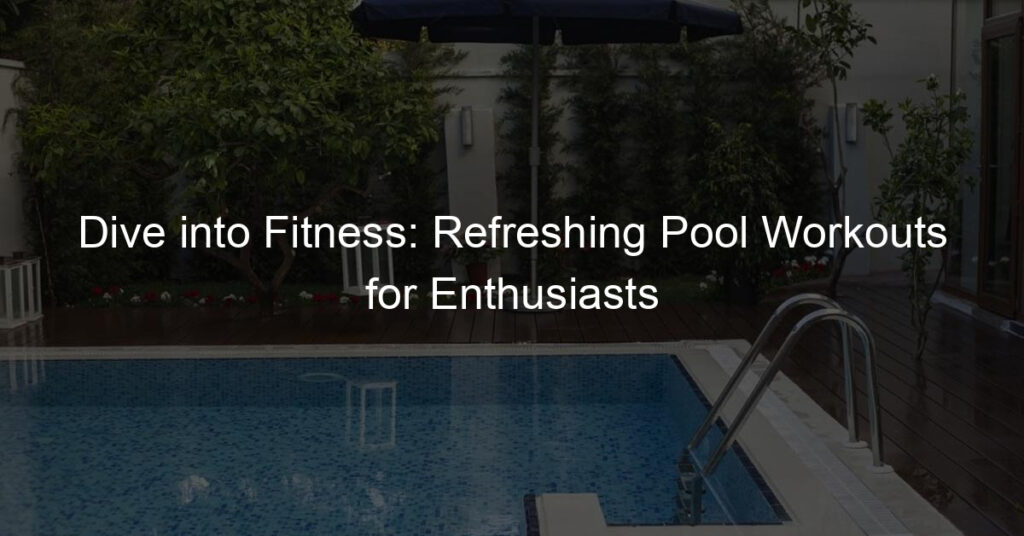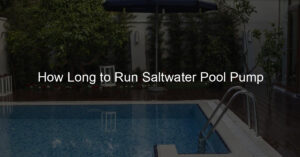Introduction to Swimming Pool Exercises
Swimming pool exercises are a fun and effective way to keep fit. They combine the benefits of cardio and strength training, making them a great choice for people of all ages and fitness levels. In this article, we will explore the benefits of swimming for fitness and the basics of aquatic workouts.
- Benefits of Swimming for Fitness
- Full-body workout: Swimming engages all the major muscle groups, providing a full-body workout.
- Cardiovascular fitness: It’s a great way to improve heart health as it increases heart rate without stressing the body.
- Strengthens muscles: The resistance of water makes muscles work harder, which helps in strengthening them.
- Improves flexibility: The wide range of movements involved in swimming can help improve flexibility.
- Low-impact: Swimming is a low-impact exercise, making it a good option for people with joint problems.
- Understanding the Basics of Aquatic Workouts
- Water resistance: Water provides natural resistance, making every movement more challenging and effective.
- Use of equipment: Equipment like water weights, noodles, and kickboards can be used to enhance workouts.
- Types of exercises: Aquatic workouts can include swimming laps, water aerobics, water yoga, and more.
- Temperature: The temperature of the water can affect your workout. Warmer water is suitable for slow, controlled movements, while cooler water is better for high-intensity workouts.
Swimming is not just a fun activity, but it’s also a fantastic way to stay fit. Here are some of the benefits:
Aquatic workouts are exercises performed in the water, usually in a swimming pool. They can range from simple movements to more complex routines. Here are some basics to understand:
Fitness Swimming Workouts: A Comprehensive Guide
Swimming is a fantastic full-body workout that can help you stay fit and healthy. It’s low-impact, fun, and suitable for all ages and fitness levels. In this guide, we will explore four different swimming styles and their unique fitness benefits.
Swimming Styles and Their Fitness Benefits
There are many different styles of swimming, each with its own unique set of benefits. Here are four popular styles:
- Freestyle Swimming
- Butterfly Stroke
- Backstroke
- Breaststroke
Also known as the front crawl, freestyle is the fastest and most efficient of all swimming strokes. It works your shoulders, back, and leg muscles, and can burn up to 600 calories per hour. Plus, it’s a great way to improve your cardiovascular fitness.
The butterfly stroke is a challenging but rewarding style. It requires strength, coordination, and rhythm. This stroke works your core, shoulders, and hips, making it an excellent full-body workout. It can burn up to 750 calories per hour.
Backstroke is a fantastic stroke for improving posture and strengthening the back and shoulder muscles. It’s also a good choice for people with neck or spine issues, as it doesn’t require you to twist your neck to breathe. This stroke can burn up to 500 calories per hour.
Breaststroke is a great stroke for beginners. It’s slower than other strokes, but it provides a thorough workout for the chest, shoulders, back, and legs. Plus, it can help improve your breathing technique. This stroke can burn up to 400 calories per hour.
Remember, the best stroke for you depends on your fitness goals, skill level, and personal preference. Don’t be afraid to try different styles and see which one you enjoy the most!
Creating Your Pool Fitness Routine
Creating a fitness routine for the pool is a great way to stay fit and healthy. Here are some steps to help you get started:
- Setting Fitness Goals
- Planning Your Workout Schedule
- Choosing the Right Swimming Techniques
Before you start your pool fitness routine, it’s important to set some fitness goals. This could be anything from losing weight, building muscle, improving your cardiovascular health, or simply becoming more active. Setting goals will give you something to work towards and will help keep you motivated.
Once you have your goals set, it’s time to plan your workout schedule. This will depend on your personal schedule and how often you can realistically commit to working out. A good starting point is to aim for at least 30 minutes of moderate-intensity exercise five days a week. Remember, consistency is key when it comes to seeing results from your workout routine.
There are many different swimming techniques that you can incorporate into your pool fitness routine. The best one for you will depend on your fitness level and goals. For example, freestyle swimming is great for building endurance, while the butterfly stroke is a more intense workout that targets the upper body. Don’t be afraid to mix it up and try different techniques to keep your workouts interesting and challenging.
In conclusion, creating a pool fitness routine involves setting fitness goals, planning your workout schedule, and choosing the right swimming techniques. By following these steps, you can create a routine that is tailored to your needs and helps you achieve your fitness goals.
Water Aerobics: A Fun Way to Stay Fit
Are you looking for a fun and effective way to stay fit? Look no further than water aerobics! This low-impact exercise is not only enjoyable but also offers numerous health benefits.
Understanding Water Aerobics
Before we dive into the benefits, let’s first understand what water aerobics is all about.
- What is Water Aerobics?
- Benefits of Water Aerobics
- Low Impact: The buoyancy of water reduces the impact on joints, making it a perfect exercise for those with joint issues or injuries.
- Full Body Workout: Water resistance engages all muscle groups, providing a comprehensive workout.
- Improves Cardiovascular Health: Regular water aerobics can help improve heart health and lung capacity.
- Boosts Mood: Like other forms of exercise, water aerobics can help reduce stress and improve mood.
- Enhances Balance and Flexibility: The water’s resistance and buoyancy can help improve balance and flexibility.
Water aerobics, also known as aquatic fitness, is a form of exercise performed in water. It combines traditional aerobic exercises with swimming movements, all done in the buoyant environment of a pool. This form of exercise is great for people of all ages and fitness levels, as it can be tailored to individual needs and abilities.
Water aerobics offers a multitude of benefits. Here are some of the key advantages:
With these benefits in mind, it’s easy to see why water aerobics is a popular choice for many people looking to stay fit and healthy. So why not take the plunge and give water aerobics a try?
Water Aerobics Exercises to Try
Water aerobics is a fun and effective way to stay fit. It involves performing a variety of exercises in the water that can help improve your strength, flexibility, and cardiovascular health. Here are some water aerobics exercises you can try:
- Water Walking
- Aqua Jogging
- Leg Lifts
- Arm Curls
Water walking is a simple yet effective exercise. It involves walking in the water, which can be more challenging than walking on land due to the water’s resistance. This exercise can help improve your balance and strengthen your leg muscles.
Aqua jogging is similar to water walking, but it’s done at a faster pace. It’s a great cardiovascular exercise that can help improve your heart health. Plus, it’s low impact, which means it’s easy on your joints.
Leg lifts in the water can help strengthen your lower body. To do this exercise, stand in the water and lift one leg to the side or to the front. Hold for a few seconds, then lower your leg back down. Repeat with the other leg.
Arm curls in the water can help strengthen your upper body. To do this exercise, stand in the water with your arms at your sides. Bend your elbows and bring your hands towards your shoulders, then lower them back down. Repeat this movement several times.
Remember, it’s important to warm up before starting any exercise routine and cool down afterward. Also, make sure to drink plenty of water to stay hydrated. With these exercises, you can enjoy a fun and effective workout in the water!
Pool Workouts for Athletes: Enhancing Performance and Stamina
As an athlete, it’s crucial to explore diverse training methods to boost your performance and stamina. One such method is swimming pool workouts. These exercises offer a unique blend of resistance and flexibility training that can significantly enhance your athletic prowess.
Benefits of Swimming Pool Training for Athletes
Swimming pool workouts are not just about splashing around. They are a strategic way to improve your athletic performance. Here are some key benefits:
- Improved Cardiovascular Fitness
- Enhanced Muscle Strength and Endurance
- Increased Flexibility
Swimming is a full-body workout that requires your heart and lungs to work harder. This increased demand improves your cardiovascular fitness, making your heart stronger and more efficient.
Water provides natural resistance, which is great for muscle training. Regular swimming pool workouts can enhance your muscle strength and endurance, making you less prone to fatigue during your athletic performances.
Swimming involves a wide range of motions that help stretch your muscles in a non-impact environment. This can lead to improved flexibility, which is essential for athletes to prevent injuries and enhance performance.
In conclusion, swimming pool workouts can be a valuable addition to any athlete’s training regimen. They offer a unique way to improve cardiovascular fitness, enhance muscle strength and endurance, and increase flexibility. So, why not dive in and give it a try?
Athletic Swimming Pool Exercises
For athletes, swimming pool exercises are not just about swimming laps. There are a variety of exercises that can be done in the pool to enhance performance and stamina. Here are three effective exercises that you can incorporate into your workout routine:
- High-Intensity Interval Training (HIIT) in the Pool
- Resistance Training with Water Weights
- Underwater Treadmill Running
HIIT is a form of cardiovascular exercise that alternates between short periods of intense anaerobic exercise and less intense recovery periods. Doing HIIT in the pool adds an extra layer of resistance, making the workout even more challenging and effective. For example, you could sprint swim for 30 seconds, then float or tread water for 30 seconds, repeating this cycle for 15-20 minutes.
Water weights are a great tool for resistance training in the pool. They can be used for a variety of exercises, such as bicep curls, tricep extensions, and shoulder presses, to strengthen and tone muscles. The resistance of the water makes these exercises more challenging than when they are done on land, leading to increased muscle strength and endurance.
Underwater treadmills are a fantastic way to get a cardio workout in the pool. The water’s resistance makes running more difficult, providing a great workout for your heart and lungs. Plus, the buoyancy of the water reduces the impact on your joints, making it a great option for athletes who are recovering from injuries.
These exercises are just a starting point. There are many other exercises that can be done in the pool to help improve athletic performance. The key is to find a routine that works for you and to stick with it. Remember, consistency is key when it comes to seeing results from your workouts.
| Exercise | Description | Benefits |
|---|---|---|
| HIIT in the Pool | Alternating between short periods of intense exercise and less intense recovery periods. | Improves cardiovascular fitness, burns calories, and builds endurance. |
| Resistance Training with Water Weights | Using water weights to perform resistance exercises in the pool. | Strengthens and tones muscles, improves muscle endurance. |
| Underwater Treadmill Running | Running on an underwater treadmill in the pool. | Provides a cardio workout, improves lung capacity, and is low impact on joints. |
Aquatic Fitness Exercises: A Complete Workout Plan
Embarking on a journey of aquatic fitness exercises can be an exciting and rewarding experience. It combines the benefits of a full-body workout with the refreshing environment of the water. Let’s dive into the warm-up exercises that are crucial to prepare your body for the main workout.
Warm-Up Exercises
Warm-up exercises are essential to prepare your body for the main workout. They increase your heart rate, improve blood flow to your muscles, and reduce the risk of injury. Here are two effective warm-up exercises you can do in the water:
- Water Walking
- Arm and Leg Stretches
Water walking is a simple yet effective warm-up exercise. Start by standing in water up to your chest. Then, walk across the pool, swinging your arms as you would on land. The resistance of the water will help warm up your muscles and get your heart rate up. Aim for 5-10 minutes of water walking.
Stretching is essential to prepare your muscles for the workout ahead. In the water, perform gentle arm and leg stretches. For example, you can lift your arm and gently pull it across your chest, or lift your leg behind you and gently pull it towards your buttocks. Hold each stretch for about 30 seconds, and remember to breathe normally.
Remember, the goal of these warm-up exercises is to prepare your body for the main workout. They should not be too intense or tiring. After completing these exercises, you should feel ready to tackle the main workout exercises.
Main Workout Exercises
After a good warm-up, it’s time to dive into the main part of your aquatic fitness routine. This section will cover three key exercises that can help you improve your strength, stamina, and overall fitness level. Remember, consistency is key in seeing results, so try to incorporate these exercises into your regular workout schedule.
- Freestyle Laps
- Water Aerobics
- Resistance Training
Freestyle swimming, also known as the front crawl, is a great way to get your heart rate up and work your entire body. It’s one of the fastest and most efficient swimming strokes, making it a staple in any swimming workout. To do a freestyle lap, you’ll alternate your arms in a windmill motion while kicking your legs up and down. You’ll also rotate your body from side to side to help propel yourself forward.
According to the American Council on Exercise, a 150-pound person can burn approximately 400 calories per hour while swimming freestyle at a moderate pace. This makes it a fantastic exercise for those looking to lose weight or maintain a healthy weight.
Water aerobics is a fun and effective way to get fit. These exercises are performed in the shallow end of the pool and often involve jumping, kicking, and arm movements. Water aerobics can help improve your cardiovascular fitness, flexibility, and strength. Plus, the water’s resistance makes these exercises more challenging than their land-based counterparts, helping you burn more calories.
A study published in the Journal of Sports Medicine and Physical Fitness found that water aerobics can significantly improve body composition, muscular strength, and blood lipid profiles in middle-aged and older adults.
Resistance training in the water is another excellent way to build strength and endurance. You can use tools like water dumbbells, resistance bands, or even the water’s natural resistance to challenge your muscles. Some effective resistance exercises include water push-ups, leg kicks, and bicep curls.
Research from the Journal of Strength and Conditioning Research shows that aquatic resistance training can significantly improve muscular strength and power, making it a valuable addition to any fitness routine.
Remember to listen to your body and adjust the intensity of your workouts as needed. With regular practice, these aquatic exercises can help you achieve your fitness goals while enjoying the refreshing environment of the swimming pool.
Cool-Down Exercises
After an intense aquatic workout, it’s important to cool down your body. This helps to gradually slow your heart rate and relax your muscles. Here are two effective cool-down exercises you can do in the swimming pool:
- Gentle Swimming
Gentle swimming is a great way to cool down after a workout. It involves swimming at a slower pace, which allows your heart rate to gradually decrease. This exercise is not only relaxing but also helps to prevent muscle stiffness. You can choose any stroke you like, but the breaststroke or backstroke is often recommended for cool-downs due to their slower pace.
- Stretching
Stretching is another excellent cool-down exercise. It helps to relax your muscles and increase your flexibility. You can do simple stretches in the pool, such as reaching for your toes, pulling your heel towards your buttock, or stretching your arms above your head. Remember to hold each stretch for at least 30 seconds and to breathe deeply and regularly during each stretch.
These cool-down exercises are a vital part of any aquatic fitness routine. They help to prevent injuries, promote muscle recovery, and improve overall fitness. So, next time you finish your pool workout, don’t rush to the showers. Instead, spend a few extra minutes in the water doing these cool-down exercises.
Swimming Pool Fitness Tips
Swimming is a fantastic way to stay fit and healthy. However, to get the most out of your swimming workouts, it’s important to follow some key tips. Here are four essential tips to help you make the most of your swimming pool fitness routine:
- Stay Hydrated
- Use the Right Gear
- Listen to Your Body
- Consistency is Key
Even though you’re surrounded by water, it’s easy to forget to drink while swimming. However, staying hydrated is crucial for maintaining energy levels and preventing muscle cramps. Always have a bottle of water nearby and take regular sips throughout your workout.
Using the right swimming gear can make a significant difference in your workout. A good swimsuit, goggles, and swim cap can enhance your performance and comfort. Additionally, using tools like kickboards, pull buoys, and fins can help target specific muscles and improve your technique.
It’s essential to listen to your body while swimming. If you feel any pain or discomfort, it’s a sign that you may be pushing yourself too hard or using incorrect technique. Remember, it’s okay to take breaks and adjust your workout as needed.
Like any other form of exercise, consistency is key in swimming. Try to swim regularly, whether it’s every day or a few times a week. Consistency will help you build stamina, improve your technique, and see progress over time.
In conclusion, swimming is a great way to stay fit, but it’s important to stay hydrated, use the right gear, listen to your body, and be consistent. By following these tips, you can maximize your swimming workouts and enjoy a healthier, fitter lifestyle.














